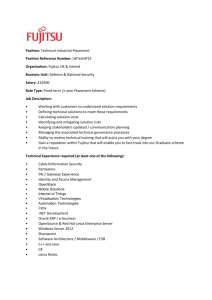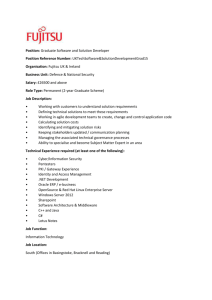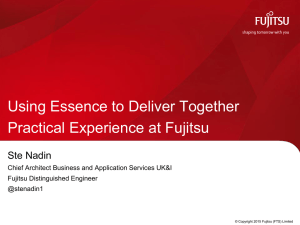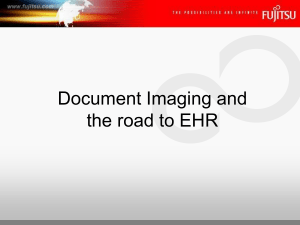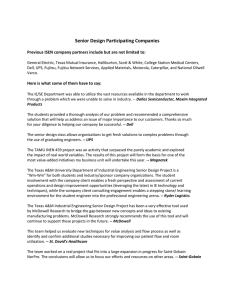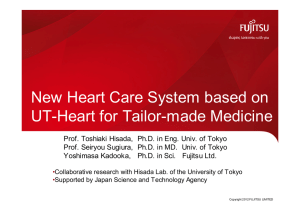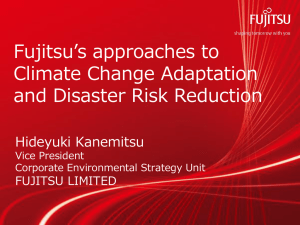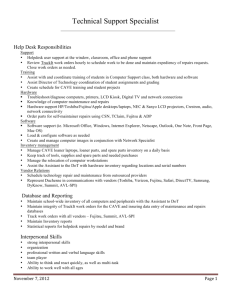Fujitsu Group Green Procurement Direction Fujitsu Limited July 9, 2013 (Edition 6.0)
advertisement
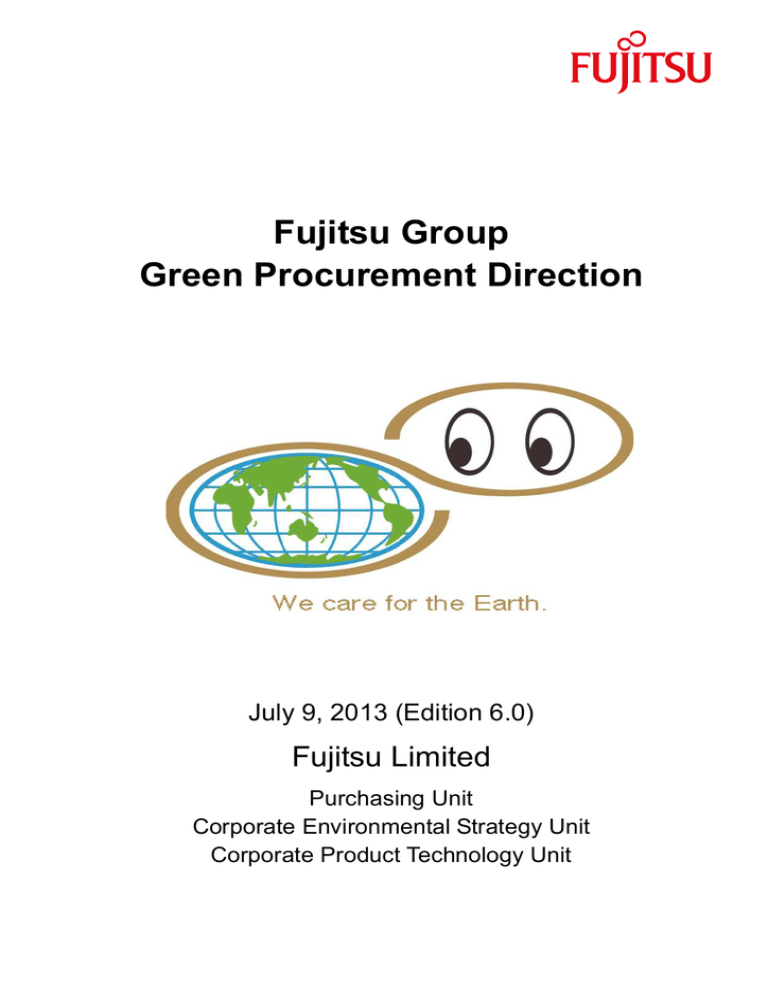
Fujitsu Group Green Procurement Direction July 9, 2013 (Edition 6.0) Fujitsu Limited Purchasing Unit Corporate Environmental Strategy Unit Corporate Product Technology Unit Table of Contents 1. Preface ................................................................................................................................................ 2 2. Fujitsu Group’s environmental policy .................................................................................................. 3 3. Introduction to the Fujitsu Group Green Procurement Direction ........................................................ 4 4. 5. 6. 3.1. Purpose ........................................................................................................................................ 4 3.2. Scope ........................................................................................................................................... 4 Green procurement requirements to be fulfilled by suppliers ............................................................. 5 4.1. Establishment of EMS ................................................................................................................. 6 4.2. Compliance with regulations on Fujitsu Group specified chemical substances.......................... 7 4.3. Establishment of CMS ............................................................................................................. 10 4.4. Approaches towards limiting or reducing CO2 emissions ......................................................... 12 4.5. Approaches towards biodiversity conservation ......................................................................... 13 4.6. Others ........................................................................................................................................ 14 Requests for implementation of environmental assessment of products ......................................... 15 5.1. Marking deliverables that use a small secondary battery ......................................................... 15 5.2. Energy saving ............................................................................................................................ 15 5.3. Consideration on recycling ........................................................................................................ 16 5.4. Easy treatment and disposal ..................................................................................................... 16 5.5. Environmental considerations for packaging materials ............................................................. 16 Information disclosure ....................................................................................................................... 19 6.1. Disclosure of information on deliverables.................................................................................. 19 6.2. Disclosure of information on suppliers ...................................................................................... 19 [Revision record] ...................................................................................................................................... 21 All Right Reserved, Copyright FUJITSU LIMITED 2013 1/21 Edition 6.0 1. Preface The Fujitsu Group is well aware of its mission as a global ICT organization. We are dedicated to sustainable growth and progress with our customers and society as we seek more ways to reduce our impact on the environment. We implement environmental management in a systematic and sustained manner. Our efforts reflect the goal of "in all our actions, we protect the environment and contribute to society." This commitment is part of the Corporate Values enshrined in the FUJITSU Way, a corporate philosophy with guiding principles for the Company and its employees. We have established an environmental concept called Green Policy 21 for the purpose of making everyone at the Fujitsu Group aware of our stance regarding environmental activities and to promote this stance in our daily business practices. Green Policy 2020 is a medium-term environmental vision that defines the roles and objectives of the Fujitsu Group between now and 2020. As one step toward reaching the goals of this medium-term environmental vision, the Fujitsu Group established the Fujitsu Group Environmental Protection Program (Stage VII) that covers the three-year period from FY 2013 to FY 2015. Under the plan, the Fujitsu Group seeks to expand its contribution to addressing environmental challenges for both customers and society by further promoting the deployment of ICT throughout society as a whole. The plan aims to leverage services and solutions to cut greenhouse gas emissions for customers and society by a total of over 26 million tons, to ensure that more than 50% of all newly developed products enable the highest levels of energy efficiency, and to increase resource efficiency by 20% compared to fiscal 2011. In addition, by continuing to emphasize environmental awareness in its own business activities while further conserving energy at production plants and offices and improving the environmental performance of its datacenters, the Fujitsu Group will aim to cut greenhouse gas emissions by 20% compared to fiscal 1990. In taking a leadership role in actively pursuing these goals across its entire global value chain with customers, partners and suppliers, the Fujitsu Group strives to shape a sustainable, prosperous society, which is at the heart of the company's corporate philosophy. With regard to procurement, Fujitsu Group has put its policies into shape as Fujitsu Group Green Procurement Direction, and has asked suppliers to conform to its requirements. Fujitsu Group will continue promoting green procurement activities based on this Direction, and taking social responsibility for the global environmental protection. We are grateful if suppliers understand Fujitsu Group's purposes and step forward with us to accomplish the same goals. All Right Reserved, Copyright FUJITSU LIMITED 2013 2/21 Edition 6.0 2. Fujitsu Group’s environmental policy Since its inauguration in 1935, Fujitsu has made environmental protection one of the top management priorities based on the concept of “creating eco-friendly products.” We drafted the Fujitsu Group Environmental Policy to promote environmental management in a way that reflects the nature of our business. Fujitsu Group has continued environmental protection activities based on this policy. Philosophy The Fujitsu Group recognizes that global environmental protection is a vitally important business issue. By utilizing our technological expertise and creative talents in the ICT industry, we seek to contribute to the promotion of sustainable development. In addition, while observing all environmental regulations in our business operations, we are actively pursuing environmental protection activities on our own initiative. Through our individual and collective actions, we will continuously strive to safeguard a rich natural environment for future generations. Principles We help customers and society reduce the environmental impact of their business activities and improve environmental efficiency with advanced technologies, ICT products and solutions. We proactively promote environmentally conscious business activities to help the environment and economy coexist harmoniously. We strive to reduce the environmental impact of our ICT products and solutions throughout their entire lifecycle. We are committed to conserving energy and natural resources, and practice the 3Rs approach (reduce, reuse and recycle) to create best-of-breed eco-friendly products and solutions. We seek to reduce risks to human health and the environment from the use of chemical substances and waste. We disclose environment-related information on our business activities, ICT products and solutions, and we utilize the resulting feedbacks to critique ourselves in order to further improve our environmental programs. We encourage our employees to work on global environmental conservation such as tackling climate change and preservation of biodiversity through their business and civic activities to be role models in society. All Right Reserved, Copyright FUJITSU LIMITED 2013 3/21 Edition 6.0 3. Introduction to the Fujitsu Group Green Procurement Direction 3.1. Purpose Fujitsu Group performs environmental activities in all business areas based on the concept of "The green policy 21 - We make every activity green". As part of these activities, it promotes the procurement of lower-environmental-load products. This Green Procurement Direction describes the philosophy on which Fujitsu Group’s green procurement activities are based and specifies what we want suppliers to fulfill. Fujitsu Group will promote global environment protection activities in cooperation with suppliers, based on this Green Procurement Direction. 3.2. Scope This Green Procurement Direction has been established as a common direction of the entire Fujitsu Group companies, and applies to procured products or goods that are applied to products sold by Fujitsu Group to customers as well as to their suppliers themselves. In this Direction, “procured products or goods” shall mean material, components, units, accessories, packaging materials, OEM/ODM products, equipment, software and services, etc., except for office automation equipment, stationery, or business consumables, etc., which are internally used in Fujitsu Group. The Fujitsu Group Companies in this Direction shall mean subsidiaries or affiliates of Fujitsu Limited, which are shown on page (20/21). In this regards, however, if a member company of Fujitsu Group presents its own direction because of its customers’ specific requirements or a particular business style, Suppliers are also requested to primarily observe such its own direction. All Right Reserved, Copyright FUJITSU LIMITED 2013 4/21 Edition 6.0 4. Green procurement requirements to be fulfilled by suppliers Fujitsu Group requires its suppliers to observe mainly the following five requirements, which the concepts are shown in Table 1. Fujitsu Group promotes procurement from suppliers who observe these requirements. In details about each requirement, please see Section 4.1 through 4.5. Table 1 Green procurement requirements to be fulfilled by suppliers Requirements (1) (2) (3) (4) (5) Establishment of EMS (Environmental Management System) Compliance with regulations for Fujitsu Group specified chemical substances Establishment of CMS (Chemical substances Management System) Approaches towards limiting or reducing CO2 emissions Approaches towards biodiversity conservation Material/parts Non-Material/parts suppliers* suppliers Required Required 4.1 Required N/A 4.2 Required N/A 4.3 Required Required 4.4 Required Required 4.5 Section *Material/parts suppliers: suppliers whose deliverables are equipped to Fujitsu Group’s products or suppliers of OEM/ODM products All Right Reserved, Copyright FUJITSU LIMITED 2013 5/21 Edition 6.0 4.1. Establishment of EMS Fujitsu group requires suppliers to establish an EMS. In principle, suppliers are requested to have an EMS certified by a third-party organization such as ISO14001. If you are a supplier which doesn’t have any EMS, we will request you to establish either Level 1 or Level 2 of EMS shown below. We support suppliers to improve their knowledge and skills for establishing a third-party EMS by making them operate Level 1 and Level 2 of EMS. [ EMS levels ] Level 3: Third-party certified EMS such as ISO14001 or ISO14005 compliant or others (including Eco Action 21, Eco Stage and KES which are Japanese major EMSs.) Level 2: FJEMS, Supplier’s own EMS ‐FJEMS, only available in Japanese, is Fujitsu group’s original EMS having basic elements of ISO14001. Suppliers which want to establish a third-party certified EMS in the future can efficiently learn EMS operations by conducting its PDCA steps. ‐Supplier’s own EMS is an EMS uniquely established and operated by a supplier. Level 1: Supplier’s environmental conservation activities & representative’s name of the activities (This EMS level is confirmed by our survey form for environmental activities.) Figure 1 EMS implementation levels required for suppliers All Right Reserved, Copyright FUJITSU LIMITED 2013 6/21 Edition 6.0 4.2. Compliance with regulations on Fujitsu Group specified chemical substances 1) Our concepts for chemical substances to be controlled: Fujitsu Group has defined its own regulations on chemical substances related to Deliverables which are equipped to Fujitsu Group’s products, or OEM/ODM products and packaging materials (hereinafter collectively called “Deliverables” in this Green Procurement Direction), and requested its suppliers to comply with the regulations. With respect to the chemical substances, Fujitsu Group has defined herein substances by referring to those related to international laws such as EU’s RoHS Directive or REACH Regulation, and the Class I substances specified by Japanese Chemical Substances Control Law, etc. In detail, please refer to the following. As for “Disclosure of information on deliverables”, please refer to the Section 6.1. 2) Fujitsu Group specified Chemical substances: Deliverables shall comply with the following regulations in the articles a). through e). However, if there are particular designations or directions in a purchase specification, drawing or other similar kind of document that includes, for example, designation regarding other chemical substances, other “standards of ban”, or other “exempted applications”, such designations or directions will prevail. “Packaging materials” herein also include the cases that they are packed by suppliers (or by a carrier that the suppliers entrust packaging) AND supplied directly to customers of Fujitsu Group without being unpacked by Fujitsu Group. In addition, also refer to the section 5.5 (Environmental considerations for packaging materials), which includes a few requests regarding environmental assessment. [Note] ・ As for fundamental ideas regarding control of Fujitsu Group specified chemical substances, also refer to “Guideline regarding non-containment management on Fujitsu Group specified chemical substances” (http://www.fujitsu.com/global/about/procurement/green/) ・ The latest version of “Fujitsu Group Specified Chemical Substances List” is available at the following URL; http://www.fujitsu.com/global/about/procurement/green/ a) Banned Substances In principle, Deliverables must not contain chemical substances defined in “Fujitsu Group Specified Chemical Substances List” (Table 1). In details of the target substances, “Standards of Ban” and calculation methods of concentration, etc., refer to “Fujitsu Group Specified Chemical Substances List” (Table 1) and its notation. Notwithstanding above, if exempted application(s) in “Fujitsu Group Specified Chemical Substances List” is(are) applicable to the Deliverables, such containment will be exempted from the restriction of the ban. All Right Reserved, Copyright FUJITSU LIMITED 2013 7/21 Edition 6.0 In this regard, however, as for Lead/Lead compounds, Mercury/Mercury compounds, Cadmium/Cadmium compounds and Hexavalent Chromium/Hexavalent Chromium compounds, Deliverables must not contain any of these substances only when Fujitsu Group specifies that such Deliverables do not contain any of these substances by a purchase specification, drawing or other similar kind of document. This article is given because Fujitsu Group occasionally has to use Deliverables that contain these substances in order to meet requirements from its customers. b) Reportable Substances Reportable Substance(s) shall be taken hold on the presence or absence in Deliverables, and if Deliverables meet “Conditions of Deliverables to be reportable” defined in “Fujitsu Group Specified Chemical Substances List” (Table 2), its total mass, purpose of use, and application area, etc., shall be reported to Fujitsu Group. In details of target substances, “Conditions of Deliverables to be reportable”, contents to be reported or managed, and calculation methods of concentration, etc., refer to “Fujitsu Group Specified Chemical Substances List” (Table 2) and its notation. Substance may be added to Reportable Substances when the obligation of information transmission becomes necessary according to international regulations such as REACH Regulation. In such cases, Fujitsu Group may ask suppliers to provide information before revising this Direction. c) Control Substances In the case that Deliverables meet "Conditions of Deliverables to be controlled" defined in “Fujitsu Group Specified Chemical Substances List” (Table 3), with respect to "Control Substance", its total mass, purpose of use, and application area, etc., shall be managed and recorded. In details of target substances, "Conditions of Deliverables to be controlled" and calculation methods of concentration, etc., refer to “Fujitsu Group Specified Chemical Substances List” (Table 3) and its notation. d) Prohibited Substances in manufacturing process During manufacture of Deliverables, it is prohibited to use Fujitsu Group specified “Prohibited Substances” that are defined as “Ozone Depleting Substances” in “Fujitsu Group Specified Chemical Substances List” (Table 4), except for HCFCs. Meanwhile, if you use HCFCs, please work to reduce the emission and/or the use. In this regard, however, the use of Prohibited Substances is exempted from the restriction if they are used in indirect manufacturing process such as analytical determination and product development, or in a freezing/an air-conditioning machine. All Right Reserved, Copyright FUJITSU LIMITED 2013 8/21 Edition 6.0 e) Other restricted substances in delivery destination counties or areas Other than the substances defined in a) through d) above, Deliverables shall at all time comply with laws and restrictions applied in delivery destination countries or areas, for example, where Deliverables are delivered to overseas sites of Fujitsu Group. For your reference, please refer to the following principal laws and restrictions in Japan and overseas that are related to chemical substances in products. However, since it is hard to provide whole lists here, please confirm by yourselves. Japan: Chemical Substances Control Law (CSCL) Industrial Safety and Health Law Law for Promotion of Effective Utilization of Resources (3R Law): Requirements for information disclosure of restricted chemical substances Law Concerning the Protection of the Ozone Layer through Control of Specified Substances and Others Measures (Ozone Layer Law) Overseas: EU member nations: RoHS Directive, REACH Regulation (Restriction) Swiss: ChemRRV Norway: Norwegian Product Regulations USA: TSCA (Toxic Substances Control Act) China: China RoHS: Administration on the Control of Pollution Caused by Electronic Information Products All Right Reserved, Copyright FUJITSU LIMITED 2013 9/21 Edition 6.0 4.3. Establishment of CMS Fujitsu Group has requested establishment of CMS of material/parts suppliers. As typified by RoHS directive, REACH regulation of European Union, so-called “China RoHS” and Japanese “J-Moss”, it has been becoming necessary in every supply chain to severely control certain chemical substances in products. Responding to this, each company in such supply chains, as their social responsibilities, needs to implement proper and effective management of chemical substances in their products. Also, industries are promoting standardization of Chemical substances management methods in products to reduce corporate’s burden, through the use of the “Chemical substances management guideline” (*1) published by Joint Article Management Promotion-consortium (JAMP) and the “JIS Z 7201: 2012” (*2) published by Japanese Industrial Standards Committee (JISC). Fujitsu Group has created “CMS Check Sheet” in accordance with the above documents. It is designed to clarify action items that Fujitsu Group would like its suppliers to take. The principal elements of CMS that Fujitsu Group would like its suppliers to manage are shown in Table 2. After suppliers’ self-checking, furthermore, Fujitsu Group visits suppliers and implement audits regarding CMS on the basis of their CMS Check Sheets to check suppliers’ situations of establishment and operation of CMS. According to the audit result, Fujitsu Group may request the suppliers to improve unsatisfactory performance in their CMS operation and also provide some advice if necessary. However, if no improvement comes out, Fujitsu Group might reconsider business relationship to such suppliers. In detail about CMS establishment and other related processes, Fujitsu Group will explain respectively to applicable suppliers. *1: “Chemical substances management guideline” can be downloaded from the JAMP’s website. (http://www.jamp-info.com/english) *2: JIS Z 7201: 2012, “Management of chemical substances in products-Principles and guidelines” Issued on August 20, 2012 can be browsed on the JISC’s website. (http://www.jisc.go.jp/eng/index.html) All Right Reserved, Copyright FUJITSU LIMITED 2013 10/21 Edition 6.0 Table 2 Management items in CMS No. Management items Outline of the required actions 1 Policy 7 Acquisition and Verification of Information of Chemical Substances in Products 8 9 Purchase Management Acceptance Verification 10 Process Management 11 Shipping Verification 12 Traceability 13 Change Control 14 Non-conformity Response 15 16 Training Management Records 17 Communication (Provision of Information) Clarifying CMS policies by corporate or business representative Clarifying management procedures and criteria for requirements from laws, industry standards or customers Clarifying products, processes, constructional elements and chemical substances to be managed Setting objectives and reviewing implemented process Clarifying responsibilities and roles in each division related to the management Taking into account compliance with the defined requirements at design and development stage. Constructing information acquisition scheme, and acquiring information of chemical substance contained in delivered items. Conveying requirements to suppliers. Implementing conformity check of delivered items with one’s defined criteria when receiving delivered items. Clarifying processes in which composition of chemical substances vary and controlling properly. Also implementing distinction control and prevention of contamination. Implementing conformity check of shipping products with one’s defined criteria or standards. Constructing traceability scheme of products and delivered items. Clarifying procedures in case that composition of chemical substances is likely to be influenced, such as changes of design, process, supplier, etc., Clarifying procedures when unconformable products come out Clarifying education contents Implementing documentation of management procedures or instructions, and controlling appropriately. Constructing information sharing system. 2 Definition of Management Criteria 3 Definition of Scope of Management 4 Establishment of Objectives & Planning for Implemented Process Definition of Organizational System, Responsibilities and Authority Design and Development 18 Performance (State of Implementation) Evaluation and Improvement Management Review (Correction by Management) Evaluating CMS implementation status, and improving performance. Reviewing and correcting problems by top management 5 6 19 of Documentation and Management items and required actions are subject to change, if necessary. All Right Reserved, Copyright FUJITSU LIMITED 2013 11/21 Edition 6.0 4.4. Approaches towards limiting or reducing CO2 emissions Fujitsu Group requests all of our suppliers to make efforts towards limiting or reducing CO2 emissions. The approaches are divided into three stages from the perspectives of making progress step-by-step. All suppliers are required to take approaches in Stage 2 at least. Note: CO2 includes the greenhouse gas (N2O, CH4, SF6, HFC, PFC, etc.). [Stage 1: Activity announcement] It is a stage where companies understand the meaning of limiting or reducing CO2 emissions and express their will to make efforts as a corporation. To approach limiting or reducing CO2 emissions, it would be ideal if a supplier could control and manage its activities with the amount of their CO2 emissions or numerical data (electricity use, fuel use, etc.) indicating CO2 emissions. [Stage 2: Activity implementation (including Stage 1)] It is a stage where companies are conducting substantive activities internally. This stage requires that companies are conducting any activities with either numerical target, policy or plan. It would be ideal if numerical target could be set because the activity status can be confirmed easily and the PDCA cycle can be followed smoothly. If it is difficult to set the numerical target because numerical data on CO2 emissions cannot be controlled, please take into account promoting activities with policies or plans based on your long-term direction of the activities. [Stage 3: Activity expansion (including Stage 2)] It is a stage where companies are expanding their activities from the internal to the external level. The extended scope of activities is carried out in Stage 3. This stage includes not only the internal activities but also the process of encouraging the upper stream supply chain to make efforts towards limiting or reducing CO2 emissions and collaborative review tasks with external organizations. Encouraging the upper stream supply chain to take the approach will allow you to reinforce the activities of limiting or reducing CO2 emissions in the entire supply chain. External organizations to collaborate include groups and related international organizations, such as industry, government, municipality, Japan Federation of Economic Organizations, NGO/NPO, etc. We refer to participation in review working groups or reviewing projects to examine/develop activities and policies, and also donation to external organizations concerned as collaboration. All Right Reserved, Copyright FUJITSU LIMITED 2013 12/21 Edition 6.0 4.5. Approaches towards biodiversity conservation Fujitsu Group has divided the approaches towards biodiversity conservation into three stages as in the case of limiting or reducing CO2 emissions and requests our suppliers to take approaches in Stage 1 at least. [Stage 1: Activity announcement] It is a stage where companies understand the meaning of biodiversity conservation and express their will to make efforts as a corporation. [Stage 2: Activity implementation (including Stage 1)] It is a stage where companies are conducting substantive activities internally. To expand approaches as a corporation, a company-wide project team led by the management layer must have been organized and established. On that basis, you will put company-wide approaches, location-specific and department-specific approaches for biodiversity conservation into practice. [Stage 3: Activity expansion (including Stage 2)] It is a stage where companies are expanding their activities from the internal to the external level. The extended scope of activities is carried out in Stage 3. This stage includes not only the internal activities but also the process of encouraging the upper stream supply chain to practice biodiversity conservation and collaborative review tasks with external organizations. Encouraging the upper stream supply chain to make efforts towards conserving biodiversity allows you to reinforce the activities in the entire supply chain while it helps you to raise awareness of the need to practice biodiversity conservation in the entire society. External organizations to collaborate include groups and related international organizations, such as industry, government, municipality, Japan Federation of Economic Organizations, NGO/NPO, etc. We refer to participation in review working groups or reviewing projects to examine/develop activities and policies, and also donation to external organizations concerned as collaboration. Stage 3 Activity expansion Stage 2 Activity implementation Stage 1 Activity announcement Figure 2 Stages of limiting or reducing CO2 emissions and biodiversity conservation All Right Reserved, Copyright FUJITSU LIMITED 2013 13/21 Edition 6.0 Table 3 Adaptation criteria in each stage concerning the activities of limiting or reducing CO2 emissions and biodiversity conservation Stage Approaches towards limiting or reducing Approaches towards biodiversity conservation CO2 emissions 3 2 Activity expansion (including Stage 2) Perform either 1) or 2): 1) Appeal to the upper stream supply chain 2) Work in collaboration with external organization(s) Activity implementation (including Stage 1) Perform activities with either numerical Perform 1) and 2) both shown below: target, policy or plan 1) Establish a company-wide organization concerning biodiversity conservation 2) Make concrete efforts Activity announcement 1 Make a public announcement to take approaches 4.6. Others The increase of global water demand and the shortage of water resources are becoming international issues because of rapid population increase and progression of water pollution. Therefore, water resources conservation is required in business activities. We would like suppliers to promote the water resources conservation as long as they can. The examples of activities are shown as follows: - Reduction of usage of water (Prevention of leaving water running, Water-saving of toilet, Cyclic use of industrial water/clean water, use of rainwater) - Prevention of water pollution (Purification of factory effluent, Regular water quality inspection) - Cleanup activities of rivers and lakes - Headwater forest conservation activities (Recharge activities of water resources) All Right Reserved, Copyright FUJITSU LIMITED 2013 14/21 Edition 6.0 5. Requests for implementation of environmental assessment of products Suppliers are requested to comply with laws or regulations applied to Deliverables. Moreover, as far as you can, please do the following environmental assessments of Deliverables. However, if there are particular designations or directions in a purchase specification, drawing or other similar kind of document, such designations or directions will prevail. Marking deliverables that use a small secondary battery Energy saving (5.1) (5.2) Consideration on recycling (5.3) Easy treatment and disposal (5.4) Environmental considerations for packaging materials (5.5) 5.1. Marking deliverables that use a small secondary battery Deliverables that use a small secondary battery shall indicate a recycle or other legal mark in accordance with the Law for Promotion of Effective Utilization of Resources. 5.2. Energy saving The operating and standby power consumption levels of deliverables shall be as low as possible and shall fulfill the following requirements: 1) Use of power saving function A deliverable that can have a power saving function shall be able to automatically reduce the power consumption of components other than the main power supply and/or separate a part of the system by means of an operator operation or schedule function. 2) Compliance with the Law concerning the Rational Use of Energy If a deliverable is specific equipment designated by the law, the following requirements shall be fulfilled. - The energy consumption efficiency must be indicated based on the law. - Consideration shall be paid to the target of energy consumption efficiency specified by the law and efforts shall be made to achieve the target. 3) Compliance with the International Energy Star Program When a deliverable is subject to the International Energy Star Program, the power consumption standard specified by the program shall be fulfilled. 5.3. Consideration on recycling Considering ease of recycling, deliverables shall fulfill the following requirements: 1) Unification of plastic materials The plastic materials used for deliverables shall be unified as far as possible. All Right Reserved, Copyright FUJITSU LIMITED 2013 15/21 Edition 6.0 2) Use of plastic materials that can be easily recycled The use of thermosetting plastics, which are difficult to recycle, shall be avoided and general-purpose plastics, which are easy to recycle, shall be used, as far as possible. 3) Suppression of use of polyvinyl chloride Use of polyvinyl chloride on deliverables shall be suppressed as much as possible, except for cable coverings and electronic component insulators (such as heat-shrink sheets), in order to prevent dioxin production when the material is improperly disposed of. 4) Painting on plastics Painting and plating on plastic material surfaces of deliverables shall be avoided as far as possible because they make it difficult to recycle the material. 5) Material identification marking Delivered plastic components with a mass of 25 grams or more and a flat surface area of 200 mm2 or more shall be marked for material identification based on the pertinent JIS or ISO standard. 6) Materials of documents attached to deliverables Manuals and documents attached to deliverables shall fulfill the following requirements: - Recycled paper shall be used for all document pages. Or, eco-friendly virgin pulp, such as FSC certified papers, is used. - Covers of documents shall be free from plastic coatings, which can be an obstacle for recycling. 5.4. Easy treatment and disposal Considering easy treatment and disposal after their use, deliverables shall fulfill the following requirements: Consideration for ease of separation and disassembly and reduction of composite parts It is necessary that deliverables can be divided and disassembled into identical material units with hands and general tools (such as Phillips screwdrivers, nutdrivers, wrenches, hexagon wrenches, tweezers, nippers, pliers and/or hammers), except when use of special screws is mandatory to prevent modifications or when disassembly should be made difficult to prevent fires or ensure safety human body safety or for other reasons. 5.5. Environmental considerations for packaging materials Suppliers are requested as much as possible to use packaging materials of deliverables that fulfill the following requirements: All Right Reserved, Copyright FUJITSU LIMITED 2013 16/21 Edition 6.0 (A) This article A shall apply to packaging materials that are supplied directly to customers of Fujitsu Group without being unpacked by Fujitsu Group. For example, software media and accessories sold with unit products and directly supplied to our customers. 1) Materials of Packaging materials Packaging materials shall fulfill the following requirements: Any corrugated board shall contain used paper as its content at 70% or more. Paper materials shall be free of plastic coating, bonding of art paper or other materials. Non-petroleum solvent ink or vegetable oil ink shall be used as much as possible for printing on package. Polyvinyl chloride shall not be used, except when appropriate alternate materials are unavailable. Protective bags shall be made of paper or polyethylene, polypropylene or other plastic materials that can be easily recycled, except for special-purpose bags. Paper bags shall be free from plastic coatings or clear plastic sheets attached at openings. 2) Marking on packaging materials Packaging materials shall fulfill the following requirement and be marked for material identification. Packaging materials by the Containers and Packaging Recycling Law shall be marked for material identification. (B) This article B shall apply to packaging materials that are unpacked by Fujitsu Group, which will be discarded or sold after delivery to Fujitsu Group. 1) General requirements Suppliers are requested as much as possible to reduce heavy metals containing Lead/Lead compounds, Mercury/Mercury compounds, Cadmium/Cadmium compounds Hexavalent Chromium/Hexavalent Chromium compounds and others. Suppliers are requested as much as possible to promote recycle and reuse. Suppliers are requested not to use Polyvinyl chloride, except when appropriate alternate materials are unavailable. Suppliers are requested as much as possible not to use materials difficult to recycle for packaging materials such as urethane sponge. 2) Loading pallet Suppliers are requested as much as possible to use a loading pallet having a structure available to use repeatedly. Suppliers are requested as much as possible to use a loading pallet made of materials that can be recycled. All Right Reserved, Copyright FUJITSU LIMITED 2013 17/21 Edition 6.0 Suppliers are requested as much as possible to reduce number of windings of stretching film. Suppliers are requested as much as possible not to use PP-band. 3) Packing boxes Suppliers are requested as much as possible to use corrugated board that contains higher content ratio of used paper. Suppliers are requested as much as possible to let packing boxes not to be mixed or attached by materials that interfere in recycle. 4) Inner packaging materials: buffering materials, trays, tapes, partition board Suppliers are requested as much as possible to make simple packaging. Suppliers are requested as much as possible not to bond different types of materials. Suppliers are requested as much as possible to reduce adhesive tapes. Suppliers are requested as much as possible to use common plastic materials such as PP, PE or PS for plastic packaging materials unless it’s used for special purpose. Suppliers are requested as much as possible to display material of plastic packaging materials based on JIS or ISO standards. 5) Methods of filling Suppliers are requested as much as possible to fill in a box by every unit specified in case the site specifies number of items in a box. Suppliers are requested as much as possible to place an item in the packing box with becoming as much bulk ratio as possible. All Right Reserved, Copyright FUJITSU LIMITED 2013 18/21 Edition 6.0 6. Information disclosure Suppliers have to submit the following information using the specified format by specified date when requested by a Fujitsu Group company. 6.1. Disclosure of information on deliverables Information of material used in deliverables, such as types of constituent materials and mass and/or concentration of each chemical substance Note: Suppliers are required to provide such information by several formats, such as JAMP information transmission tool (AIS, MSDSplus), Fujitsu Group original format, or a format specified by Fujitsu Group’s customer. Information of non-containment of specified chemical substances Note: Suppliers are required to provide a Non-use certificate, Non-containment certificate, or Warranty of compliance with Fujitsu group requirement for chemical substance Form. Analysis data of deliverables Note: As for fundamental ideas regarding analysis of Fujitsu Group specified chemical substances, please also refer to “Guideline regarding analysis on Fujitsu Group specified chemical substances” (http://www.fujitsu.com/global/about/procurement/green/). OEM product assessment results if the Fujitsu Group company has requested this information in accordance with the Fujitsu-specified regulations on environmental assessment of products. Risks in terms of quality, performance and environment involved in changing production conditions of time-proven materials used in deliverables (4M change) 6.2. Disclosure of information on suppliers Status of environmental protection activities Note: Suppliers are required to provide a Fujitsu Group Environmental Activity Survey Form. All Right Reserved, Copyright FUJITSU LIMITED 2013 19/21 Edition 6.0 [List of Fujitsu Group Companies] No. 01 02 Company name Fujitsu Limited 03 Fujitsu IT Products Limited 04 Fujitsu I-Network Systems Limited 05 Fujitsu Telecom Networks Limited 06 Fujitsu Interconnect Technologies Limited 07 Fujitsu Advanced Engineering Limited 08 Fujitsu Kasei Limited 09 Fujitsu CoWorCo Limited 10 Fujitsu Component Limited 11 Fujitsu Fsas Inc. 12 Shinano Fujitsu Limited 13 Shimane Fujitsu Limited 14 Fujitsu Peripherals Limited 15 Shinko Electric Industries Co., Ltd. 16 Fujitsu General Limited 17 Transtron Inc. 18 Fujitsu Network Solutions Limited 19 Fujitsu Marketing Limited 20 PFU Limited 21 Fujitsu Frontech Limited 22 Fujitsu Wireless Systems Limited 23 Fujitsu VLSI Limited 24 Fujitsu Optical Components Limited 25 Fujitsu Semiconductor Limited 26 Fujitsu Computer Products of Vietnam, Inc. 27 Fujitsu Network Communications Inc. Fujitsu Isotec Limited Fujitsu Group members may vary in the future. All Right Reserved, Copyright FUJITSU LIMITED 2013 20/21 Edition 6.0 [Revision record] Jun 25, 2001 (Edition 1) Created Jul 23, 2003 (Edition 2) Revised in part. Oct 28, 2003 (Edition 2.1) Changed Fujitsu Group companies. Nov 1, 2004 (Edition 3.0) Set maximum concentration values for impurities, etc. May 1, 2007 (Edition 4.0) Changed specified chemical substances, Fujitsu Group companies, etc. Jul 1, 2008 (Edition 4.1) Added PFOS to specified chemical substances. Deleted DecaBDE as the exempted application for PBDE. Changed Fujitsu Group companies. Oct 1, 2009 (Edition 4.2) Revised specified chemical substances e.g. added new category as “Reportable Substances” Deleted three exempted applications Revised Fujitsu Group companies, etc. Jan 21, 2010 (Edition 4.3) Added 14 substances to Reportable Substances. May 13, 2010 (Edition 5.0) Added approaches of limiting or reducing CO2 emissions and biodiversity preservation Moved the details of Fujitsu Group specified chemical substances by creating Fujitsu Group Specified Chemical Substances List Oct 25, 2010 (Edition 5.1) Changed Fujitsu Group companies. Oct 11, 2011 (Edition 5.2) Revised in part (Clause4.2, Clause6.1, etc.) Jul 9, 2013 (Edition 6.0) Re-examination of EMS levels, Re-examination of Stages of limiting or reducing CO2 emissions, etc. FUJITSU LIMITED Green Purchasing Dept., Purchasing Engineering Div., Purchasing Unit E-mail: green@ml.css.fujitsu.com Phone: +81-44-754-3561 Fax: +81-44-754-3586 Download URL: http://www.fujitsu.com/global/about/procurement/green/ All Right Reserved, Copyright FUJITSU LIMITED 2013 21/21 Edition 6.0
